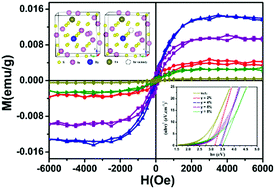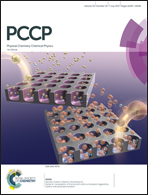Tunable photoluminescence and room temperature ferromagnetism of In2S3:Dy3+,Tb3+ nanoparticles†
Abstract
Trivalent lanthanide-doped luminescent nanomaterials have unique spectral and magnetic properties, which have been extensively investigated due to their potential application prospects in a number of new technologies. The rare earth Dy3+ and Tb3+ ions co-doped β-In2S3 dilute nanoparticles with different doping concentrations were successfully synthesized by a gas–liquid phase chemical deposition method. The band gap energy could be tuned by varying the doping concentration from 3.17 to 3.51 eV. The In2S3:Dy3+,Tb3+ nanoparticles exhibited strong photoluminescence emission peaks and room temperature ferromagnetism. Under excitation at 352 nm, the intrinsic emission and transitions of 5D4 → 7F6 for Tb3+ and 4F9/2 → 6H13/2 for Dy3+ were observed. The saturation magnetizations presented an increasing trend and then decreased as the doping concentration increased. This can be ascribed to the fact that the enhanced antiferromagnetic interaction suppresses the ferromagnetic behavior after the doping concentration reaches a certain value. In addition, VASP first-principles calculations were used to further shed light on the magnetic origin and chemical bonding mechanism of the as-prepared samples. It was found that the magnetism could be attributed to In vacancies and the co-doped system is in favor of the formation of In vacancies. This study provides experimental and theoretical guidance for the design and synthesis of promising candidates for optical, magnetic, and spintronic applications.



 Please wait while we load your content...
Please wait while we load your content...